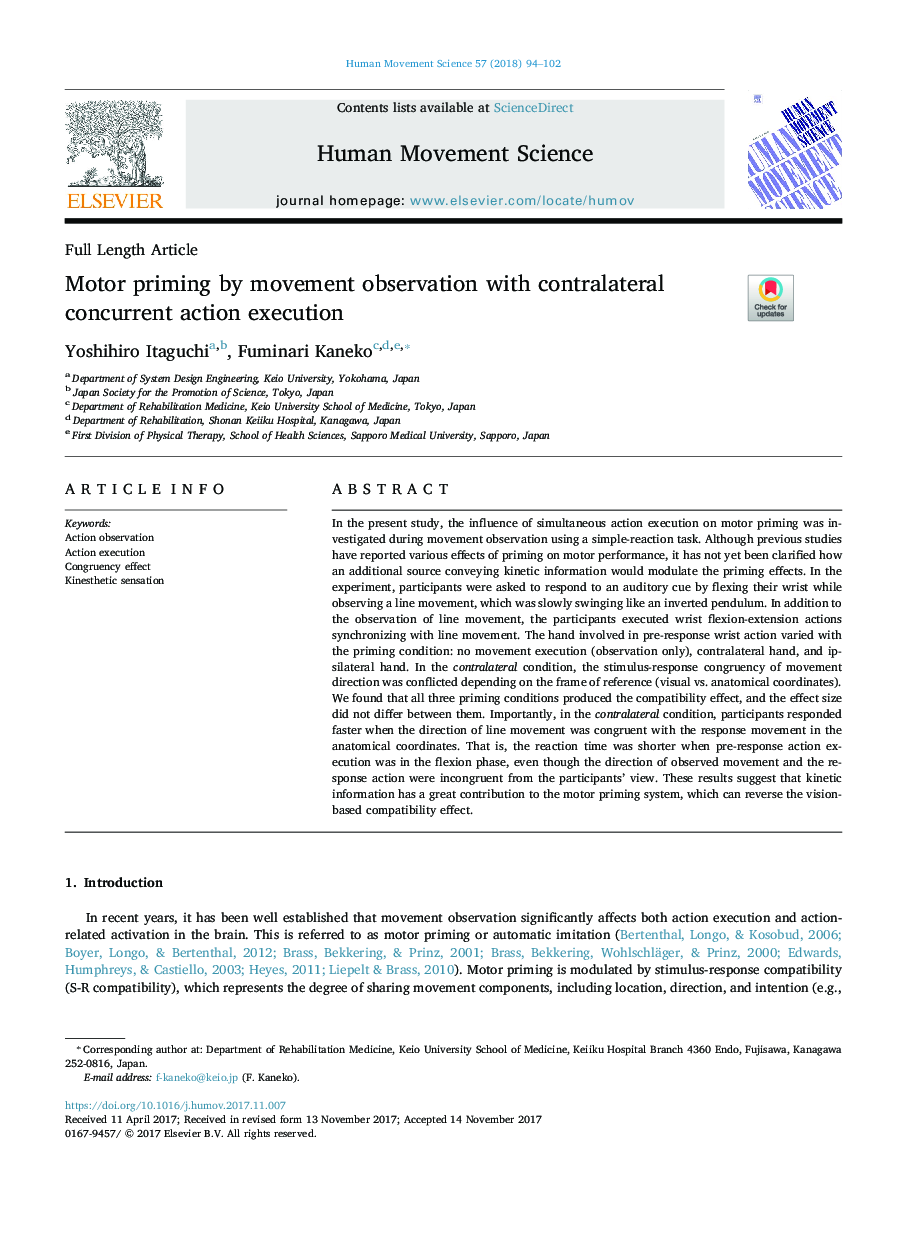| کد مقاله | کد نشریه | سال انتشار | مقاله انگلیسی | نسخه تمام متن |
|---|---|---|---|---|
| 7290944 | 1474207 | 2018 | 9 صفحه PDF | دانلود رایگان |
عنوان انگلیسی مقاله ISI
Motor priming by movement observation with contralateral concurrent action execution
ترجمه فارسی عنوان
پرایمر موتور توسط مشاهدات حرکتی با اجرای عملی همزمان یک طرفه
دانلود مقاله + سفارش ترجمه
دانلود مقاله ISI انگلیسی
رایگان برای ایرانیان
کلمات کلیدی
مشاهده فعالیت اعدام عملی اثر متقابل، احساس گرسنگی،
ترجمه چکیده
در مطالعه حاضر تأثیر اجرای همزمان همزمان بر روی حرکتی موتور در طی مشاهده حرکت با استفاده از یک کار ساده واکنش مورد بررسی قرار گرفت. اگرچه مطالعات قبلی اثرات متفاوتی از چسبندگی بر روی عملکرد موتور را گزارش کرده است، هنوز مشخص نشده است که چگونه یک منبع اضافی انتقال اطلاعات جنبشی، اثرات اولیه را تعدیل می کند. در این آزمایش، شرکت کنندگان از پاسخ دادن به یک نشانه شنوایی خواسته می شدند که از دست دادن مچ دست خود را در حالی که مشاهده یک حرکت خط، که به آرامی در حال چرخش مانند یک آونگ معکوس. علاوه بر مشاهده جنبش خط، شرکت کنندگان اجراهای فرمت فلکس - مچ دست را هماهنگ با حرکت خط. دست درگیر در عمل مچ دست قبل از واکنش با شرایط اولیه متفاوت است: اجرای حرکت (فقط مشاهده)، دست طرف مقابل و دست راست. در شرایط کنترلی، همگرایی محرک-پاسخ به جهت حرکت در بسته بندی فریم مرجع (بصری و مختصات آناتومیک) متناقض بود. ما دریافتیم که هر سه شرایط پرایند اثر سازگاری را تولید می کنند و اندازه اثر آنها بین آنها متفاوت نیست. مهمتر از همه، در شرایط کنترلی، شرکت کنندگان سریعتر پاسخ دادند وقتی که مسیر حرکت خط با حرکت واکنش در مختصات آناتومی هماهنگ بود. یعنی زمان واکنش زمانی کوتاهتر بود که اجرای عملیات پیش از واکنش در فاز خمشی، حتی اگر جهت حرکت مشاهده شده و پاسخ واکنش از نظر شرکت کنندگان متناقض بود. این نتایج نشان می دهد که اطلاعات جنبشی سهم بزرگی در سیستم پرایمر موتور دارد که می تواند اثر سازگاری مبتنی بر بینایی را تغییر دهد.
موضوعات مرتبط
علوم زیستی و بیوفناوری
علم عصب شناسی
علوم اعصاب شناختی
چکیده انگلیسی
In the present study, the influence of simultaneous action execution on motor priming was investigated during movement observation using a simple-reaction task. Although previous studies have reported various effects of priming on motor performance, it has not yet been clarified how an additional source conveying kinetic information would modulate the priming effects. In the experiment, participants were asked to respond to an auditory cue by flexing their wrist while observing a line movement, which was slowly swinging like an inverted pendulum. In addition to the observation of line movement, the participants executed wrist flexion-extension actions synchronizing with line movement. The hand involved in pre-response wrist action varied with the priming condition: no movement execution (observation only), contralateral hand, and ipsilateral hand. In the contralateral condition, the stimulus-response congruency of movement direction was conflicted depending on the frame of reference (visual vs. anatomical coordinates). We found that all three priming conditions produced the compatibility effect, and the effect size did not differ between them. Importantly, in the contralateral condition, participants responded faster when the direction of line movement was congruent with the response movement in the anatomical coordinates. That is, the reaction time was shorter when pre-response action execution was in the flexion phase, even though the direction of observed movement and the response action were incongruent from the participants' view. These results suggest that kinetic information has a great contribution to the motor priming system, which can reverse the vision-based compatibility effect.
ناشر
Database: Elsevier - ScienceDirect (ساینس دایرکت)
Journal: Human Movement Science - Volume 57, February 2018, Pages 94-102
Journal: Human Movement Science - Volume 57, February 2018, Pages 94-102
نویسندگان
Yoshihiro Itaguchi, Fuminari Kaneko,
